Day 0 is excitement. Day 0 is chaos. Day 0 goes fast but you are always waiting. Day 0 is days, months, years, decades of work coming together in one kickoff celebration with the athletes of the world who understand your efforts like no one else does. Day 0 is the first day the world really pays attention to the games en masse. Day 0 can only mean one thing: it’s the opening ceremony of the Paris 2024 Paralympic Games.
A lot happens on the opening ceremony day. The village, after a week of operations, has begun to run smoothly, and the focus now turns to the reason everyone is here: the sport. The morning, as always, starts in the village with the chef de mission meeting—a gathering of all national leaders to update them on key operations and to raise any issues with key operators of the games. This meeting has an additional agenda item: a detailed presentation on how to move everyone out of the village and into the city center to officially get the games started. Having led the chef de mission meeting at the 2018 Asian Para Games on opening ceremony day, I can’t stress how important this meeting is. The briefing is detailed, the timings of everyone are critical, food and fluids are essential, and everyone needs to work together to ensure it ends in a memorable night for all.
The Sport Day
For the UCI and many other sports, it’s the last day of preparation. The last day to ensure the venue and the team are ready to showcase on the biggest stage. The past few days for para-cycling have been dedicated to official training at the velodrome and meetings with all key stakeholders. Our main sport team is our primary contact, but briefings with medical, sport presentation, victory ceremonies, and broadcast are critical in the days leading up. We also have adaptation checks for para-cycling equipment to ensure the riders’ gear meets the regulations between cycling rules and the athletes' medical needs (no public photos from this).
The Paralympic Torch relay also made a stop at the para-cycling track venue. At the last minute, the Paris 2024 cycling sport manager, Anne Lepage, was selected to carry the torch into the venue. As she entered the stadium, she was greeted by all of her sport staff and volunteers, whom she has led for days, weeks, and years. It was a fantastic choice, and you could feel how happy the team was to see her, knowing she deserved the opportunity. The team was inspired by seeing the Paralympic Flame coming into their venue carried by a leader they believed in, which really set the tone for the beginning of the competition and the energy that came from it.
On the morning of the 28th, there is a final training session for athletes. For UCI staff and officials, it’s the final preparation for the competition days. As training finishes, we hold the team managers’ meeting. Key people explain the competition procedures, rules, and specific items of concern for the event. The key figures for the competition, including myself, the Paris 2024 team, my co-technical delegate, and the head official, all speak on topics relevant to their roles that nations should take note of. For me, the key point is the increased broadcast and media focus, ensuring the schedule is respected at all times. The benefits of this are compounded for the sport and the athlete. The better the sport looks, entertains, and stays on schedule, the more broadcast interest, which in turn means TV time for the athlete. This visibility can be used to build their personal brand as well. Overall performances are reviewed post-games, and resources may be allocated based on how well the sport was received by the masses.
After the team managers’ meeting, one final, extremely important item takes place: a full dress rehearsal. This is the chance for everyone to work together as planned to ensure the whole event is in sync. Test competitions are run with officials in full positions, with cameras, sound, lights, announcers, and timing all operating to detect any issues. One of the more special experiences is that young athletes get the opportunity to compete in these simulated events, allowing them to feel the potential and magic of competition in the same venues as their idols. We get to learn as they compete. The rehearsal never goes exactly as planned, but it usually goes well enough that everyone feels ready for Day 1 of competition. But this is still Day 0, and there’s a lot more happening later today.
The Athletes’ Day
As rehearsals are finishing at midday, all athletes are heading back to the village. While they are still hours away from being presented in the parade of nations, the logistical operation to move nearly everyone out of the village has already started. Hundreds of buses are being fueled, food, water, and seating are being set up in all holding areas, and an army of staff and volunteers is moving into position to guide athletes all the way to the Place de la Concorde.
This is where the chef de mission briefing begins to take effect. Every nation will have been given a specific time frame to be ready and in their official opening ceremony attire. Every athlete and staff member is given a card identifying their timing and location to assist the ceremonies team with logistics. This “ready time” can be up to 6 hours before the ceremony even begins. The main transport mall is fully prepared with hundreds of buses, but for this massive operation, a second loading zone is also created to move all the athletes out as quickly as possible. Over 4,000 athletes and team staff, including roughly 1,000 wheelchair users, are preparing to depart the Paralympic Village at nearly the same time. Remember, these athletes are preparing to compete as early as tomorrow and still need to be as rested as reasonably possible. Volunteers and staff meet each group at their accommodation and escort them through long queues of fences, prepared to line everyone up in their proper order. The goal is to get everyone to their destination, but also in the correct order to enter the stadium as planned. Once the buses start to move, it will take upwards of 4 hours to get everyone out of the village, but there’s still a long way to go before it begins.
As the bus departs, volunteers provide food and water to keep everyone feeling good. Not being hungry goes a long way in setting a positive mood when there’s a lot of waiting. Normally there is traffic, but not with the police escort that each group of buses receives, zipping them into the center of Paris in record time for a Wednesday afternoon. First, the athletes arrive at the holding area before the athletes' parade, where they wait up to 4 hours before the ceremony starts. More food, water, drinks, and entertainment are provided to keep spirits up. Some athletes have been on the move for hours already, and the 4-hour ceremony hasn’t even started yet. As spectators move toward the temporary stadium in Place de la Concorde, athletes are putting on their jackets and lining up in proper order. Flags and flag holders are distributed, and then it’s showtime.
After an introductory performance with explosions in the colors of the French flag and jets flying over the city, the stadium opens to over four thousand athletes in procession down the Champs-Élysées. There are over sixty thousand spectators in the stadium and millions, if not billions, watching from around the world. As the parade of nations progresses into the stadium, the athletes have a few options. Reserved seating is ready for them to enjoy the celebration. Again, more food and drinks are available. It’s already been a long day. Many athletes will be thinking about their competitions after the march and getting rest. Again, the planning is in place. Buses are hidden just out of view, and when an athlete feels ready, they can take a short walk and hop on a bus back to the village. Some will stay until the ceremony ends and then head back to rest after what was hopefully a night to remember for them.
The Spectator Experience
For officials, we are lucky at this Paralympics to have the opportunity to attend the opening ceremony. Our preparation work is mostly finished early in the day since all staff for the games are focused on logistical operations. Paris is a great city for public transport, and so we are able to easily travel to the city center, have some dinner, and enjoy a once-in-a-lifetime experience at the opening ceremony in one of the most famous areas of Paris.
For me, the ceremony was emotional. It’s the start of something special, but also the culmination of 10+ years of work at the USOPC, IPC, and now UCI, celebrated by the world. The moment that stands out most was seeing all the athletes standing on the Champs-Élysées lined up with the Arc de Triomphe in the background, with the Agitos on it. Really, truly amazing for the Games, the growth of parasport, and the work the Paris 2024 team has done to change its city and country. After the parade of nations, the ceremony includes a number of performances and features about key athletes. Speeches are given by IPC President Andrew Parsons and Paris 2024 President Tony Estanguet. I found Tony’s speeches at both the Olympics and Paralympics to be some of the most authentic and genuine ceremony openings of all time. His work and what he spoke about were evident throughout the culture of the Paris 2024 organizing committee. It takes a true leader to create something like that with an organization as big as Paris 2024. After the speeches conclude, President Macron officially opens the games.
As the ceremony starts to conclude, the Paralympic Flame is brought into the stadium for its final procession. Several key French athletes were already featured in the Olympic opening ceremony, another sign of how inclusive the Paris 2024 team has been. But now it is completely their show, and many are back again to hold the torch. A few very famous international athletes also get a chance to share the stage. Oksana Masters from the USA, who competes in para-cycling, is one of the few international athletes to have the honor of showing the flame to everyone in the stadium. As the flame moves along, it is taken out of the stadium to the Paralympic Cauldron a few hundred meters away, where the final five torchbearers jointly light the final flame—the flame that will light up the night sky of Paris for 11 more great days of sport.
An extremely emotional night is then over. The Paris 2024 team is still working hard, though, with a reverse logistics operation in place to get everyone back to their beds. And while emotions are running high and excitement builds, tomorrow the festival moves to the side, and the competition truly begins. More on the sport aspect in the next post!
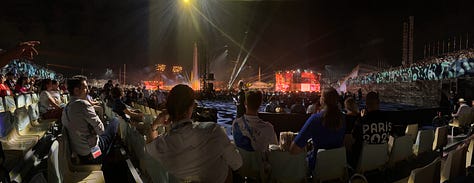

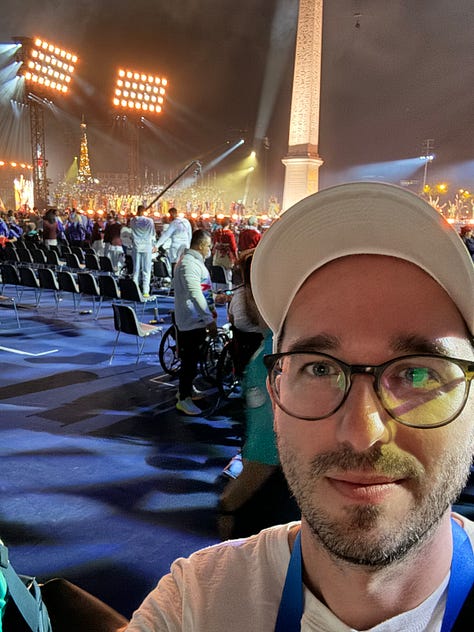
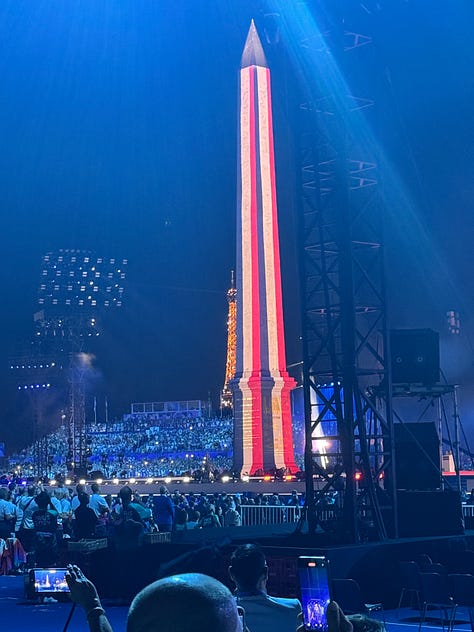
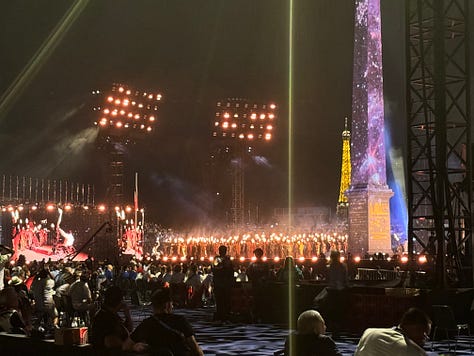
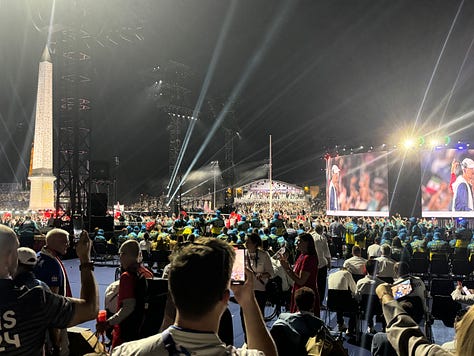





Thank you for documenting your experiences in Paris. I have learned so much about the Paralympics and Olympics and the work you are involved with. Keep posting!!